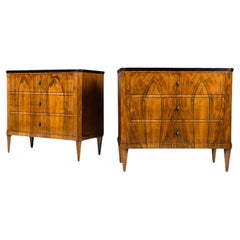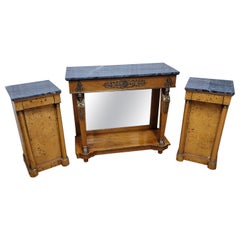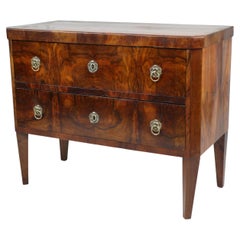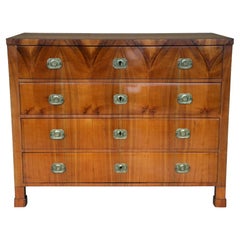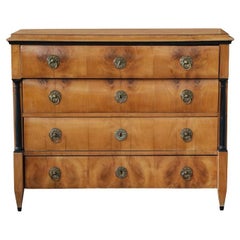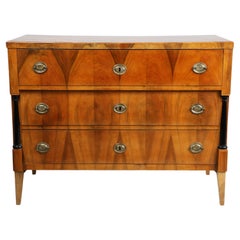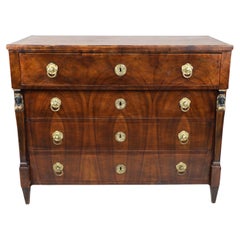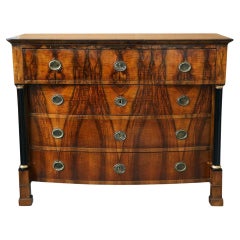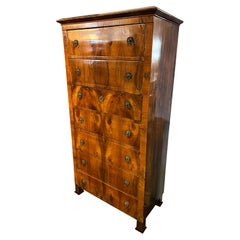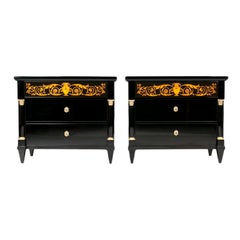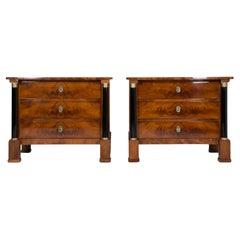Set Of 2 Biedermeier Chest
Antique Early 19th Century German Biedermeier Commodes and Chests of Dra...
Walnut
Antique Late 19th Century Biedermeier Commodes and Chests of Drawers
Marble, Brass
Antique Early 19th Century Austrian Biedermeier Commodes and Chests of D...
Brass
Antique 19th Century Austrian Biedermeier Commodes and Chests of Drawers
Brass
Antique Early 19th Century Austrian Biedermeier Commodes and Chests of D...
Cherry
Antique Early 19th Century Austrian Biedermeier Commodes and Chests of D...
Brass
Antique Early 19th Century Austrian Biedermeier Commodes and Chests of D...
Brass, Gold Leaf
Antique Early 19th Century Austrian Biedermeier Commodes and Chests of D...
Walnut
Antique Early 19th Century Austrian Biedermeier Commodes and Chests of D...
Brass
Recent Sales
Antique Early 19th Century Austrian Biedermeier Commodes and Chests of D...
Pine
Antique Early 19th Century German Biedermeier Commodes and Chests of Dra...
Walnut
Antique Late 19th Century Swedish Biedermeier Commodes and Chests of Dra...
Pine, Birch
Antique Early 19th Century French Biedermeier Commodes and Chests of Dra...
Mahogany
Antique Early 19th Century Biedermeier Commodes and Chests of Drawers
Walnut
Antique Early 19th Century Austrian Biedermeier Commodes and Chests of D...
Walnut
Antique Early 19th Century German Biedermeier Commodes and Chests of Dra...
Cherry, Spruce
Antique Early 19th Century German Biedermeier Commodes and Chests of Dra...
Walnut
Antique Early 19th Century German Biedermeier Commodes and Chests of Dra...
Walnut
Antique Mid-19th Century Austrian Biedermeier Commodes and Chests of Dra...
Nutwood
Antique Early 19th Century Austrian Biedermeier Commodes and Chests of D...
Walnut
Antique Early 19th Century German Biedermeier Cabinets
Mahogany, Cherry, Oak, Pine
Antique 19th Century German Biedermeier Commodes and Chests of Drawers
Ebony, Maple
Antique 19th Century Commodes and Chests of Drawers
Ebony
People Also Browsed
21st Century and Contemporary Swedish Mid-Century Modern Table Lamps
Textile
Vintage 1920s French Louis XVI Commodes and Chests of Drawers
Brass
Mid-20th Century German Biedermeier Commodes and Chests of Drawers
Birch
Antique Early 19th Century German Biedermeier Commodes and Chests of Dra...
Walnut, Softwood
Antique Mid-19th Century French Louis XVI Commodes and Chests of Drawers
Marble, Bronze
Antique 19th Century German Biedermeier Commodes and Chests of Drawers
Walnut, Spruce
Antique 19th Century German Biedermeier Commodes and Chests of Drawers
Walnut, Spruce
Antique Mid-19th Century Austrian Biedermeier Commodes and Chests of Dra...
Nutwood, Spruce
Antique 1820s German Biedermeier Commodes and Chests of Drawers
Walnut
Antique 19th Century Italian Commodes and Chests of Drawers
Walnut
Antique Early 19th Century Austrian Biedermeier Commodes and Chests of D...
Brass
Antique Early 19th Century Austrian Biedermeier Commodes and Chests of D...
Brass
Set Of 2 Biedermeier Chest For Sale on 1stDibs
How Much is a Set Of 2 Biedermeier Chest?
A Close Look at Biedermeier Furniture
The authentic Biedermeier furniture on 1stDibs is representative of the first modern European decorative style not dictated by the tastes of the aristocracy. Following the Napoleonic wars, a growing, wealthy urban middle class in the German-speaking states of Central Europe began to demand rights and privileges once granted only to nobles. To avoid trouble, the upwardly striving confined their political discussions to one another’s homes. And so the salon was born.
Cabinetmakers in cities such as Vienna, Berlin and Mainz began to offer goods that reflected the tastes and needs of the new class. The makers of Biedermeier chairs, tables and other furniture used little or no gilding, silver hardware or other lavish ornament. Ebonized trims are common on Biedermeier cabinetry, and neoclassical elements — lyre-shaped chair splats, carved scrollwork, table supports shaped like Greek columns. But the strongest aesthetic statement came from the wood — richly-grained, honey-colored, often book-matched veneers of walnut and fruitwood.
There are two iconic Biedermeier furniture forms, both made to outfit rooms designed for conversation. One is the sofa, deeply upholstered with a strong, architectural wooden frame. The second is the circular pedestal table, which stood at the center of the room, offering a surface on which to place coffee and cake services; or to roll out a map, or sketch out ideas on paper.
“Biedermeier” was originally a derogatory term — it derives from the pen names of two German magazine writers who mocked bourgeois manners. Looking at the elegant and refined antique, new and vintage Biedermeier furniture offered on 1stDibs, that is now an amusing irony.
Finding the Right Commodes-chests-of-drawers for You
Shopping for a commode or a chest of drawers?
Commode is the French term for a low chest of drawers, but it is also sometimes used to denote any case piece with a particularly intricate design. The commode dates to circa 1700 France, where it was used as an alternative to a taller cabinet piece so as to not obscure paneled, mirrored or tapestried walls. Coffers, or chests, which were large wooden boxes with hinged lids and sometimes stood on ball feet, preceded chests of drawers, a fashionable cabinet furnishing that garnered acclaim for its obvious storage potential and versatility. The term commode was also used to refer to a piece of bedroom furniture — a washstand or nightstand that contained a chamber pot.
As time passed, French and British furniture makers led the way in the production of chests of drawers, and features like the integration of bronze and ornamental pulls became commonplace. Antique French commodes in the Louis XV style were sometimes crafted in mahogany or walnut, while an Italian marble top added a sophisticated decorative flourish. This specific type of case piece grew in popularity in the years that followed.
So, what makes a chest of drawers different from a common dresser? Dressers are short, and chests of drawers are overall taller pieces of furniture that typically do not have room on the top for a mirror as most dressers do. Tallboys and highboys are variations of the dresser form. Some chests of drawers have one column of four to six long drawers or three long drawers in their bottom section that are topped by a cluster of small side-by-side drawers on the top. To further complicate things, we sometimes refer to particularly short chests of drawers as nightstands.
Even though chests of drawers are commonly thought of as bedroom furniture to store clothing, these are adaptable pieces. A chest of drawers can house important documents — think of your walnut Art Deco commode as an upgrade to your filing cabinet. Nestle your chest near your home’s front door to store coats and other outerwear, while the top can be a place to drop your handbag. Add some flair to your kitchen, where this lovable case piece can hold pots, pans and even cookbooks.
When shopping for the right chest of drawers for your home, there are a few key things to consider: What will you be storing in it? How big a chest will you need?
Speaking of size, don’t dream too big. If your space is on the smaller side, a more streamlined vintage mid-century modern chest of drawers, perhaps one designed by Paul McCobb or T.H. Robsjohn-Gibbings, may best suit your needs.
At 1stDibs, we make it easy to add style and storage to your home. Browse our collection of antique and vintage commodes and chests of drawers today.
